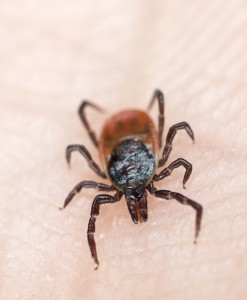Deer tick extermination in Southbury, CT is so common that our company has an entire route just for the Southbury and Woodbury areas. The reason why so many customers in Southbury are concerned with deer ticks is that it is a very wooded area with many families with small children. Small children are especially vulnerable to tick bites since they often play in areas that ticks frequent.
Why is the Deer Tick So Dangerous?

Deer ticks are a problem as they’re the main carrier of Lyme disease. Lyme disease is very debilitating and can alter a person’s life for the time that the disease is active. It can be difficult to diagnose as it can mimic other diseases. A trained medical professional should be consulted if there is ever a question if you’re infected or have been exposed to Lyme.
Are There Other Names for the Deer Tick?
Yes, the deer tick is also commonly called a black legged tick or a bear tick.
How Does the Deer Tick Become Infected?
Deer ticks received their name from their association with the white tailed deer. However, deer are only a means of transportation for the tick get around. The actual strain of Lyme is picked up from the white footed mouse, a common rodent found in the Northeast. The strain of disease is picked up during the nymph stage of the tick’s development.
What is the Life Cycle of the Deer Tick?
The deer tick has a complicated life cycle that takes place of over a two-year period; it may extend to four years if food sources are scarce.
Adult ticks feed on the white tailed deer primarily during the winter months. On the deer they mate, with the male dying shortly thereafter. In the spring the female drops off and deposits about 3,000 viable eggs. After several weeks eggs hatch and the 6-legged larva can be found moving about. The highest months of activity for the larva are from June to September. They feed once on small animals and prefer the white footed mouse. These larva over winter and emerge as 8-legged nymphs the following spring, when they feed on larger animals like raccoons, squirrels and dogs. Their population peaks in June and July, and they molt into adults in the fall.
The life cycle continues with the main focus on feeding and eventual reproduction where the female gives birth and dies.
How Can I Protect Myself from Lyme Disease?
There are many ways to protect yourself and your family from Lyme disease but the most important is to do tick checks. As mentioned, small children are especially vulnerable to ticks as they frequently play in areas where ticks are present.
The proper way to perform a tick check is to examine the body from top to bottom. Pay particular attention to the areas of the back of the neck and skull, folds at the rear of the knee and pant leg areas. Long hair can hamper a complete inspection so be as thorough as possible. Inspection may also be hampered by the fact that ticks are very mobile in the first 4 hours after a host has been found.
Deer ticks are dangerous and should be taken very seriously. A yard treatment with a labeled product and a bodily inspection are both viable treatment methods. It is important to remember that no treatment is 100% effective but the alternative makes any prevention worth the time and effort it takes.
Schedule Your Appointment Today
To schedule your appointment with an Envirocare tick exterminator, simply fill out the form. We’ll be in touch within one business day.
